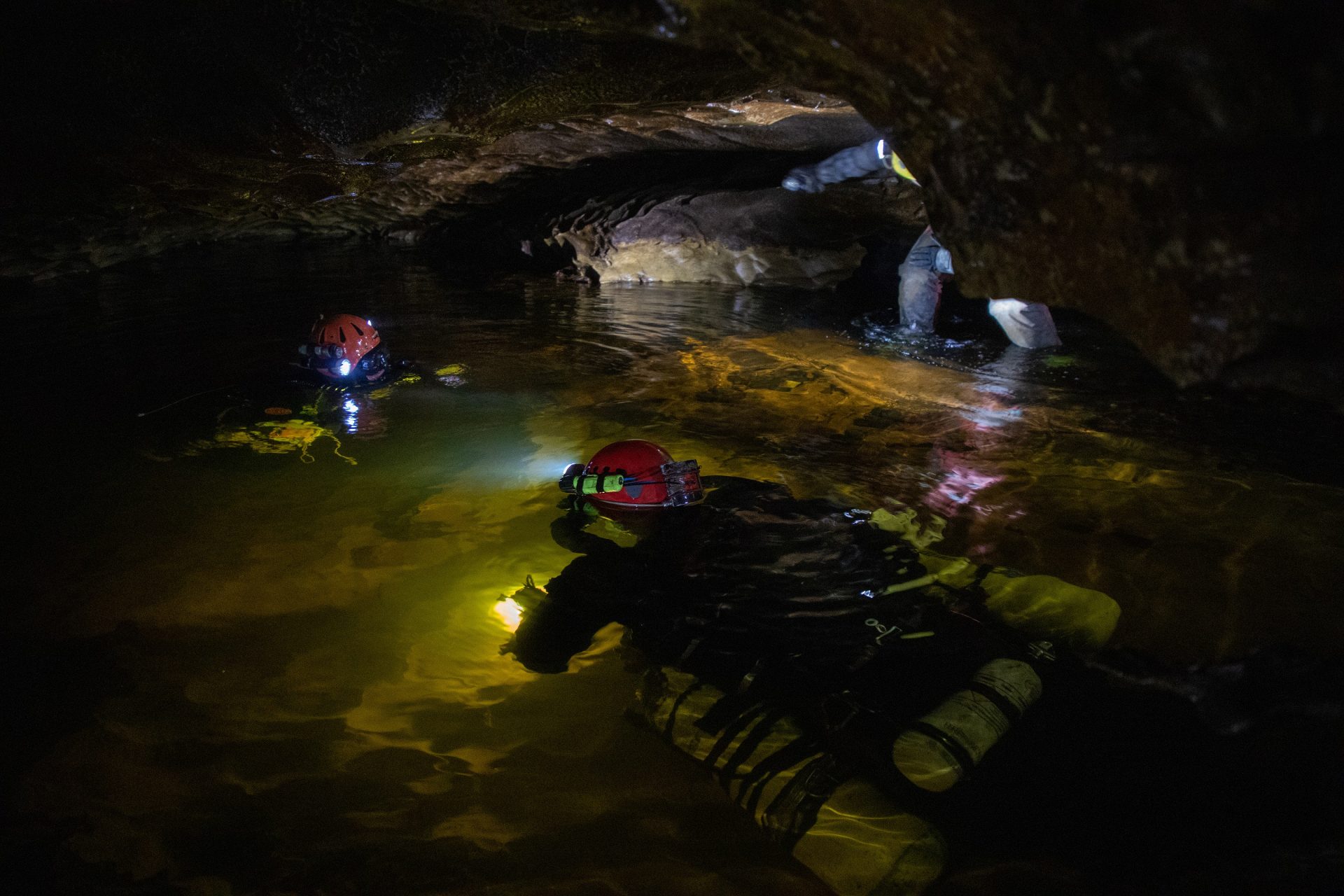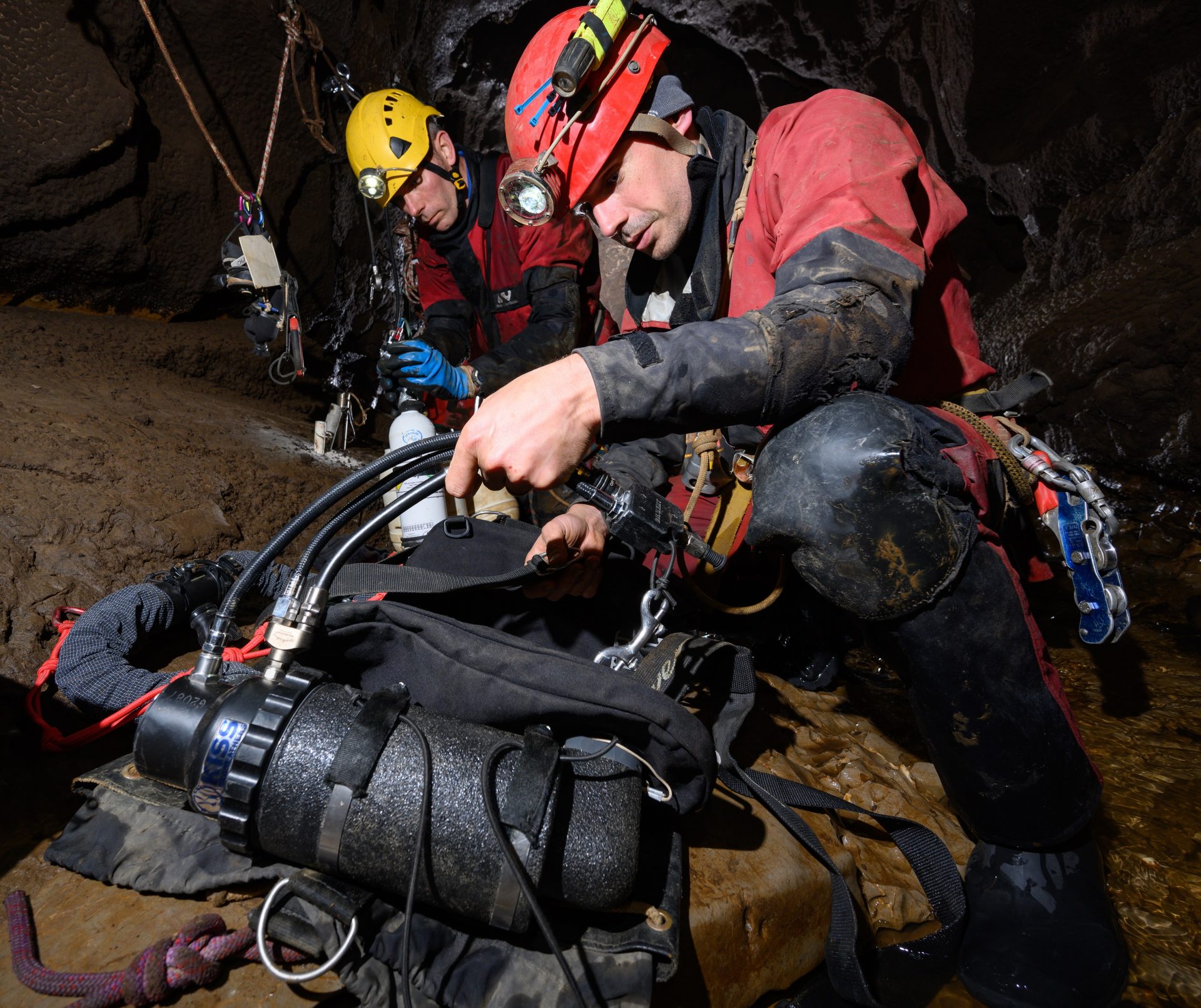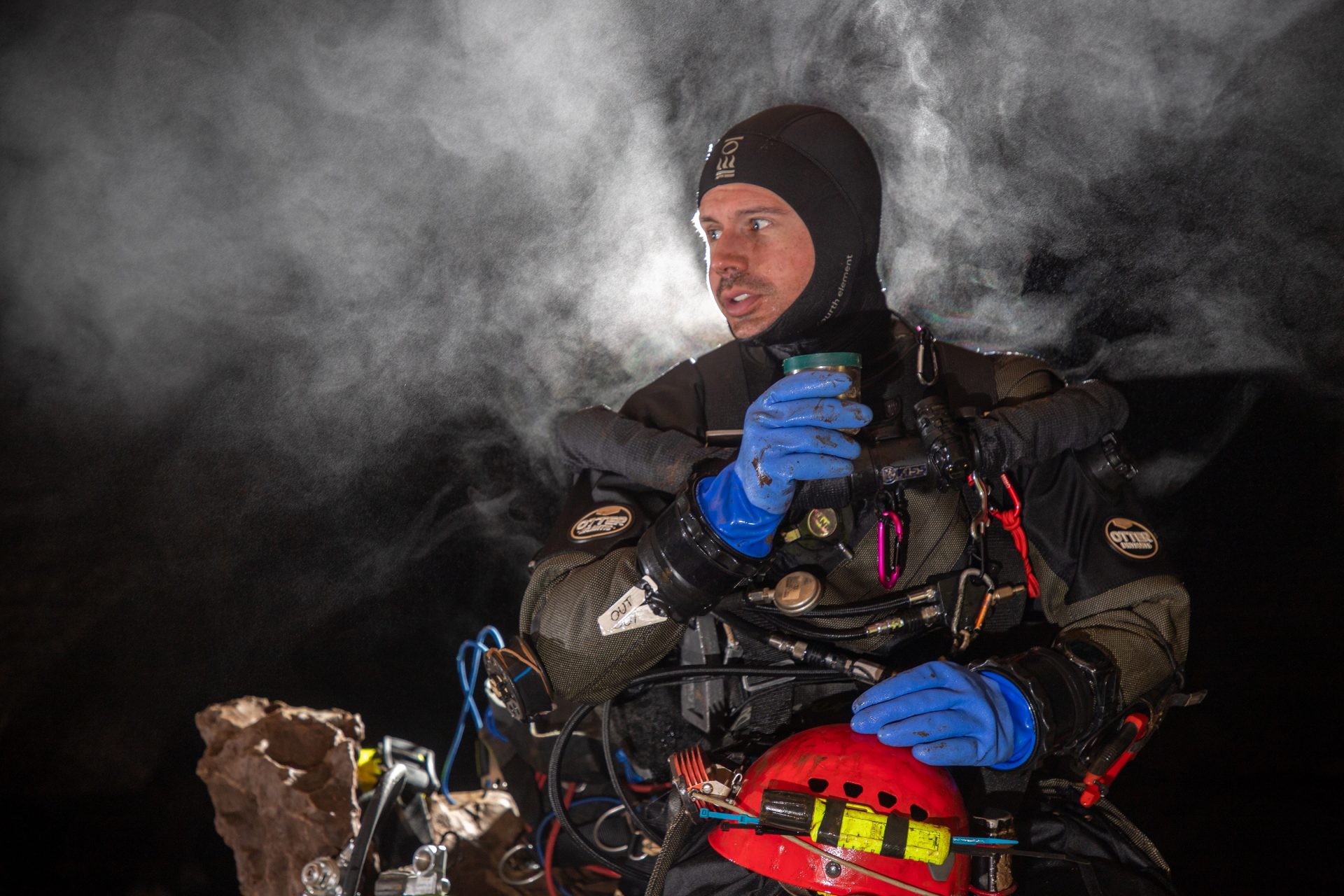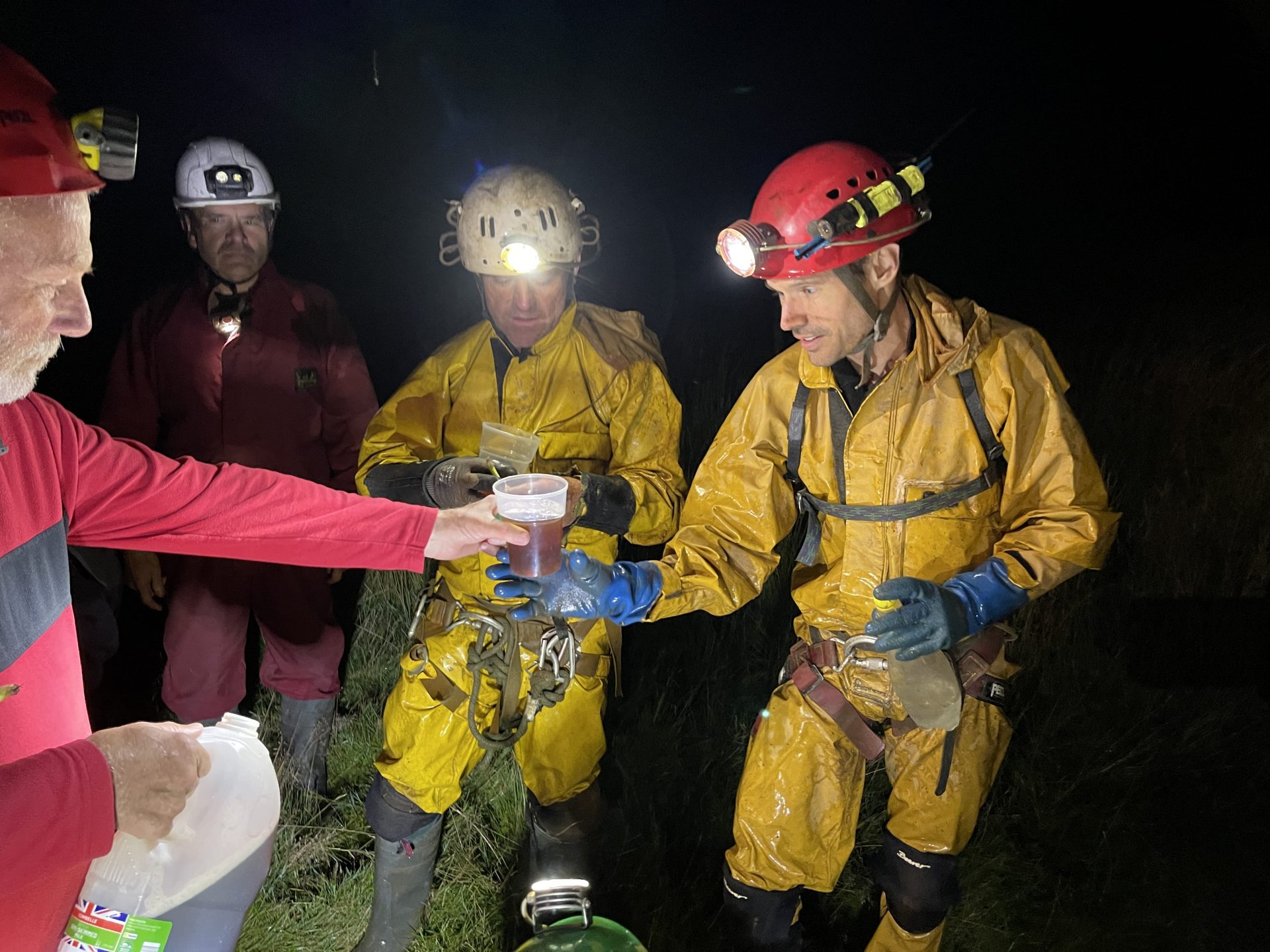
Two of Britain’s most proficient cave divers recently completed the formidable challenge of a full traverse from one end of the Three Counties cave complex to the other. The newly elected chair of the British Caving Association Russell Myers tells us the story of this incredible achievement.
The Traverse – conception and planning
On September 29th 1946, George Cornes, out prospecting with Bill Taylor, sat down in a shakehole on Casterton Fell and noticed the grass wafting about at his feet leading to the discovery of what was to become Lancaster Hole, the key entrance into the country’s longest cave system to date at 87 km. The cave extends under parts of the three counties of Cumbria (then Westmorland), Lancashire and Yorkshire sprawling out in a network of passages beneath the Fells of Casterton, Leck and Ireby.
An immense amount of exploration has gone into discovering this network of interlinked passages and access points via numerous other entrances, some of the key connections including diving sumped passages. In 2010 a major connection was made when South East Inlet was discovered off an obscure side passage just below Well Pitch in Ireby (it is now more usually entered by the Transpennine Express – an excavated crawl which bypasses the original flat out duck). Pushed through to the Temple of Doom series in Rift Pot, this linked cave systems in Yorkshire and Lancashire. The final piece fell into place in 2011 when, after a sustained and heroic effort, a tortuous 140m long dig connected Sir Digby Spode’s inlet in Notts II to Lyle Cavern High Level Series in Lost Johns’, making the 89km long three counties system a reality.
All this raised the tantalising idea of the longest through trip completely underground in the country, something which I, along with many cavers, have always found attractive; the likes of Dowber Gill Passage, Calf Holes – Browgill, Top Entrance OFD to the original entrance and so on. Go in one entrance and come out of another; there is something fundamental and appealing about it. And so it must have seemed to someone I received correspondence from in 2020 whilst BCA Secretary. Here is the gist of the text:
“I’ve come across details of the 3Cs system and wondered if it was possible to go down one entrance at one extremity of the system and emerge out of an entrance at the other extremity because I would very much like to do it. By the way, I’ve never been caving yet.”
I thought it was a wind-up from a close colleague and prepared to respond accordingly in earthy Anglo-Saxon, but my erstwhile executive colleagues cautioned a more reasoned reply, which I composed, finishing with the comment “This would be the most audacious caving trip in the UK”. No reply came back but it piqued my curiosity to ask around to see if it had been done. Consensus opinion suggested it hadn’t and the idea went on the back burner.
A few months later, my fortunes had changed and I had reluctantly become the Chair of BCA inheriting some of my predecessor “Mad” Phil Rowsell’s ideas to stimulate British caving once the Covid pandemic was over. These included a Northern Caving Festival and a trip to the PSM both of which ended up crashing on the Covid rocks. I was looking for inspiration for something we might achieve, given that the Covid restrictions at the time allowed groups of only 6 at outdoor events. The 3Cs traverse came to mind and I circulated an email asking if was a viable project. Kevin Gannon’s response was a huge “YES, let’s get on with it”. The blue touch paper had been lit and after months of Covid restrictions and boredom, Kevin ripped into the project with gusto.
It quickly became apparent why no one had attempted the Traverse in the ten years or so that it had been viable; the sump between Lost Johns and Pippikin Pot is 750 metres long, and the Pip end described as “gnarly”, comprising roof pendants and large accumulations of silt. Anecdotally, Geoff Yeadon, diving this section 30 or so years ago described it as the neckiest dive he had done. The sump had been dived from Lost Johns and the two dive lines connected but no one had dived from one end of the sump to the other – yet!
In total there is a collective 1,400 metres of sumped passage to negotiate; it may be more, as a way round the “gnarly” section has been found at the Pip end using Shuttleworth Pot to access the sump and create a link from there to Pip via Pooh’s Revenge and Alcove sumps.
The project took off with the formation of a core group to consider the issues with Kevin acting as the co-ordinator, which was sensible really, with him being CDG Northern Section Secretary and having all that watery stuff to deal with. A budget was worked up for the equipment the project required – £4,000. A request to the BCA to underwrite that amount fell on stony ground – bolitics! Fortunately, a very kind, anonymous donor came forward and we had 1,400 metres of rope – that was going to be the biggest obstacle and in true caver fashion, we’ve begged, borrowed and scrounged the rest of the gear including help from the CPC amongst many others.
Back to the actual traverse, the two extremities are Large Pot to Top Sinks, a distance underground of over 10km. Bull Pot of the Witches was considered as an extremity of the 3Cs, being slightly further west than Top Sinks but the additional distance of a couple of kilometres or so to Top Sinks, emphasises the “extreme” in “extremity” and so this quickly became the objective.
To cover my back, (these things happen), it is worth noting the potential for an even greater traverse which would eclipse the planned one by a country mile if a connection were to be made from Keld Head, Kingsdale, penetrating west in the Marble Steps Branch towards The Eastern Front in Rift/Large. This would create the potential for a through trip from Brown Hill Pot incorporating the previously named “Underground Eiger”, the watery stuff, of East and West Kingsdale systems. Indeed, if a connection is made from Dale Barn Cave/Illusion Pot into the Kingsdale system, Chapel-le-Dale hoves into view but we run out of limestone as far as I can tell, to get into the Ingleborough systems. I think we had enough on our plates for the time being, with what we were going to attempt.

In outline the route planned was; Large Pot/Rift to Ireby Fell, Ireby to Notts & Notts 2, Notts 2 to Lost Johns, Lost Johns to Pippikin via Shuttleworth Pot, Pippikin to Link Pot, Link to the Earby Series of Lancaster Hole, the high level route to Easegill at Stop Pot (passing through Corne’s Monster Cavern – nice coincidence close to his 75th Anniversary), Stop Pot, Holbeck Junction, maybe take in Easter Grotto for the pretties, Nagasaki, Limerick Junction and finally exiting the system up Walrus pitch and Top Sinks entrance. See Patrick’s more detailed description below.
Patrick Warren did a superb job reproducing the Three Counties survey with the surface topography attached to this article and also producing stats of distances and then estimated timings for travelling through the route – it looked like being a long day! By mid September, it seemed that two divers were in the running to make the attempt. I apologise for not naming everyone involved to this point, so many were involved in preparing the route, rigging entrances and preparing equipment as well as other divers working in the sumps, it would be quite a challenge. The divers were particularly active sorting out old dive lines and finding a way round the “gnarly” bit.
This is an example of some of the feedback from a dive Tony Seddon undertook during the preparation phase..
“Excellent work with Adele Ward taking down another 15l today.
Quick reconnaissance-by-fire dive in Alcove sump today using a pair of 7s that have been there a couple of months.
Vis c 1m but without a hand held light it would have been less. Line in mainly good nick. Forty minute underwater obstacle course to 24m, using only one cylinder as the dive could achieve nothing useful beyond familiarisation and line checking.
Anticipate a proper dive w/c 26th because if the forecast holds good the conditions should be helpful by then!”

To this point there had been a lot of hard work put in by a lot of people. What mystifies me, is why no one else latched onto the potential for the Traverse and triggered an attempt before now.
The planned route (Patrick Warren)
From Large Pot to Top Sink Large Pot – descend the first three pitches (p8, p12, p8) and proceed to Colossus (p46) which drops into Necropolis (a large fossil phreatic passage).
NW now goes through the Eldon extension and a duck (the Mouse Trap; bypassed by Grime and Punishment) into Coates Cavern where Rift Pot enters. From Coates Cavern continue W into the Kendal extensions and the Temple of Doom series. This is mostly crawling, past the connection to Low Douk, several loose chokes and squeezes, underneath the Yorkshire-Lancashire border, to the connection with Ireby Fell Cavern via South East inlet, joining the lower main streamway a little way below Well pitch.
In Ireby, go downstream into Duke Street and up a short pitch (p6) from Whirlpool chamber into Skylight passage which bypasses the 18m sump to Duke Street II. Skylight passage then drops into the downstream canal continuation of Duke Street II, which ends in a 226m dive to emerge into Notts Pot near the bottom of the 8th pitch.
From Notts Pot, drop down the 9th pitch (p6) to access a 210m dive to Notts II.
In Notts II, follow the main streamway downstream to Sir Digby Spode’s inlet on the right; Committee Pot (aka Iron Kiln) enters further downstream from the left. Sir Digby Spode’s inlet passes Bruno Kranski’s Rising Sump to enter a tortuous 140m long scaffolded dig emerging at the top of a boulder choke in Lyle Cavern High Level series in Lost Johns’.
Whilst nominally in Lost Johns’, Lyle Caverns High Level series (a possible camping spot) is usually accessed from Boxhead Pot via the Tate Galleries. The way on though is down Helictite Rift to a pitch (p19) and a rope climb (p4) into Lyle Cavern itself and the start of the Lost Johns’ Master Cave. Downstream passes Groundsheet junction after 180m, then a lengthy section including the Long Pool passes an inlet where Death’s Head Hole joins, before eventually running into the main downstream sump. From here, a 765m dive past several junctions attains Pooh’s Revenge (where an optional additional 30m dive avoids an awkward traverse), then a further 224m dive reaches Waterfall Chamber in Pippikin.
Following the Pippikin streamway upstream underneath the Hall of the Ten now joins the classic Easegill Traverse (Pippikin to Top Sink).
The Easegill Traverse goes via Link Pot (Hylton Hall), Echo Rift (p26), Wormways, underneath the Lancashire-Cumbria border, to the 88’ pitch (p27) in the navigationally-complex EPC ‘71 series (aka Stake Pot series), and the high level traverse from Lancaster Hole to Stop Pot. Upstream then leads to Holbeck Junction, Thackray’s Passage, the Assembly Hall, Limerick junction (again navigationally complex), and eventually reaches the surface at Top Sink (p18, p6).
The Three Counties System – lengths and distances (Patrick Warren)
The total length of the system is around 87 km, having been revised upwards, and downwards (!), several times in recent years [this latest estimate is from Descent 240]. For the traverse, the underground distance between Large Pot and Top Sink was estimated at 10.89 km (6.8 miles) by tracing over the passages on the available surveys listed below and incorporating the sump lengths quoted in the Northern Sump Index (2015), comprising some 2,100m of submerged passages in total. This includes 340m of there-and-back duplicated distance between the dive base in Shuttleworth Pot (Witches Cave II) and the submerged junction between the Lost Johns’ main downstream sump and the way through to Pooh’s Revenge in Pippikin Pot.
By way of comparison the likewise underground distance between Large and Bull Pot was estimated to be 9.85 km (6.1 miles), despite this having the greater as-the-crow-flies distance between entrances (4.89 km for Large-Bull versus 4.26 km for Large-Top). Finally, to put this in perspective, the similarly estimated underground distance for the classic Easegill Traverse between Pippikin Pot and Top Sink is ‘only’ 3.87 km (2.4 miles), for a crow-flies distance of 1.58 km.
The surveys used to make the length estimates were:
Ireby-Rift-Large: MMMMC (2010, 2013) Notts Pot: ULSA (1969) Notts II: MMMMC (2013) Lost Johns’: Waltham compilation (1970) Easegill-Pippikin: BCRA compilation (1983) Bull Pot: RRCPC (1969)
The accompanying map shows this traced path highlighted in red, with the sumps traced from surveys in the Northern Sump Index highlighted in blue, superimposed on top of the current compilation of all the surveyed cave passage in the Three Counties System plus sundry other caves in the area (in black). This survex data is taken from the Cave Registry Data Archive, and is shown on top of the Ordnance Survey (OS) 1:25k map tiles downloaded from the OS VectorMap District data portal, with usage and publication covered by Open Government Licence (OGL) terms.
References: Northern Caves 3 (2017 edition);
Northern Sump Index (2015 edition).
We now had a firm plan, an agreed route and the enthusiasm to make it work.

The Three Counties Cave System Traverse – Execution
Russell takes up the story again.
At 4.30 am on Sunday 26th September, Jason Mallinson of Huddersfield and Chris Jewel of Cheddar emerged from Top Sink, an entrance into the fabled Three Counties System, having completed an arduous 17½ hours of extreme caving and diving to complete the Grand Traverse of the system.

On Saturday 25th September, in the Ingleton Community Car Park at 10.00 am, 50 or more cavers were milling about renewing friendships and making new ones. They were being organised into various support teams, pork pies were distributed (essential caver food), and there was a palpable buzz of excitement and expectation in the air that something special was about to happen. The crowd quickly dissipated to the respective cave entrances they would use to access the system and provide the necessary support to Jason and Chris. The two divers were underground at the planned start time of 11.00 am and the adventure unrolled with the first crunch obstacle looming in the form of a particularly nasty, tight bit of passage connecting the Large/Rift Pot section with the next, Ireby Fell Cavern. The obstacle was quickly overcome however, and the two cave divers plus members of the support teams were on their way.

Kev Gannon located himself strategically on Leck Fell with his back-up crew to co-ordinate activities and receive progress reports from support teams emerging from the cave after Jason and Chris had passed the key milestone points. The Traverse plan was coming to fruition and running like clockwork but the two divers were beginning to gain time and at one point were 2 ½ hours ahead of schedule. Support teams had to be scrambled into action early to avoid missing the allocated time and to ensure they were available to assist Jason and Chris with retrieving or supplying diving equipment as they approached one sump, divested their diving equipment and also changed into “dry gear” for the next, above water sections. Over 2 km of diving would eventually be undertaken by the divers before they had completed the Traverse and a further 8 km + of “dry” caving completed before they emerged at Top Sink.


After the last sump dive into Pippikin Pot, Chris de-kitted from his diving equipment and asked for his dry gear, it arrived seconds later from the surface entrance of Mistral, delivered “just in time” by the phenomenal support team. The support teams really were the unsung heroes of this adventure without whom it would not have succeeded. At one point, a member of one team commented in passing that this was like being on an “expedition”; it really did have that feel.

The Red Rose Cave and Pothole Club had very kindly made their accommodation Bull Pot Farm on Casterton Fell available as a “base camp” for the duration of the weekend where support teams could rest and be fed and generally prepare for what they had to do next. The 3Cs project team were most grateful for their hospitality.
So, everything went according to plan with little doubt of the outcome other than an anxious half hour when the member of the support team with detailed knowledge of the last leg of the route to Top Sink through Easegill Caverns, found one section “the Wallows” had silted up with gravel. A frantic half hour of boot work succeeded in kicking and scrabbling enough gravel out to squeeze through the diminutive low passage; a close shave.

The rest of the leg was without incident and Chris and Jason emerged looking remarkably well after their superhuman achievement to a welcoming applause and a glass of beer from the assembled supporters who had trudged over Casterton Fell in the early hours to greet them.
It truly had been an exceptional event of the highest order in caving circles, but to put it into context, a film made in 1979 about the phenomenal interconnected cave passages and sumps in adjacent Kingsdale was titled the “Underground Eiger”; Kevin’s comment early in the planning of the 3Cs Traverse placed it more on a par with an “Underground K2”; an expedition indeed.

Celebrating the achievement – Jason Mallinson, Chris Jewel and Paul Swire (aka Be Ardy). Paul accompanied Jason and Chris through the last leg of the traverse to Top Sink. Photo: Mark Burkey.
Quote of the weekend: from Dave Morris to me “Do you know you’re the oldest bloke here?” My response to him, “I thought it was you”!
Further Reading:
- Northern Caves – The Three Counties System and the North-West
- The book “Adventures Underground” by Dave Haigh and John Cordingley devotes a whole chapter to the Three Counties System, including vivid descriptions of the making of the Ireby-Rift connection, and the Lost Johns’ – Notts II connection (also there is an excellent diagram of the Three Counties System in this chapter).
- Personal account by Patrick Warren of the Ireby-Rift connection is in the CPC Record 101, 29-33 (Jan 2011). Available here
Correspondents: Russell Myers and Patrick Warren
